
In the River TAKAHARA --Vol.67--
Great Sedge

The Hirayu River flows into the left bank of the Takahara River at the lower reaches of Takara Bridge.
My fishing time for 10 years from 1982 was mostly spent in a mountain stream, the Takahara River and its tributaries in Gifu Prefecture. I learned lots of fishing technique through various experiences. The river was not near Tokyo but I often went there because the river was very attractive. Let me explain first how different this river was from others.

The Takahara River on the opening day of March 1st. Who can imagine that evening rises happen here?
The Takahara River was the source of the Jintsu River that flowed into Toyama Bay. It flowed from the North Japan Alps through the never-ending steep slope to the sea, just like other rivers in Toyama Prefecture. The slope was unbelievably steep in the source area. It looked more like a long waterfall than a river. That was why the river turned into a terrible overflowing river at the time of high water. It was so dangerous that we needed special care in snow melting and typhoon seasons, when a dried creek suddenly changed into a waterfall. Actually, many anglers and mountaineers who neglected a warning of flood became victims of the disaster.
My regular fishing place was around Tochio village at the upper reaches of the long Takahara River. In those days I never thought that I would try to fish cherry salmon in the future in its main stream, the Jintsu River. Around Tochio, the river slope was much gentler than the source area but the rain easily changed the river into muddy water in snow melting season, which refused anglers’ access. In fact I had several experiences of waiting for 3 days at the hotel without fishing and coming home, discouraged.
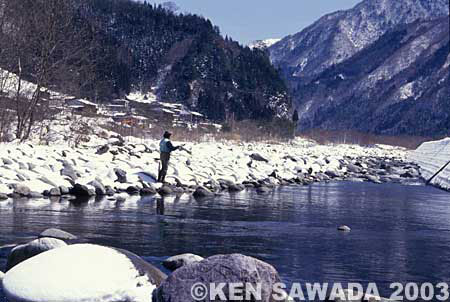
Low water before snow melting season. In the clear daytime yamame trout made rises in the big pool.
In spite of the terrible overflowing river, the Takahara River had some attractive points. One was that rich hot-spring welled up at both Tochio area and the Hirayu River, a tributary which flowed here into the Takahara River. There was an outdoor hot-spring on the bank. That meant warm spring-water flowed into the river here and there. If a large amount of warm water flows in, the water temperature rises there. In dry season of extremely low water, hot-spring water has a great effect on the river. In fact, on the opening day of March 1st plenty of aquatic insects hatched in the steam from the river, whereas the bank was thickly covered with snow. We could enjoy fishing at the evening rise, surrounded by snow, as far as we put up with cold.
Evening rises started from the beginning of March. In other words, early spring here provided anglers early-summer fishing. That was why the Takahara River became important to me. It enabled me to catch beautiful fish even in early spring, together with the Katsura River and the Oshino River.
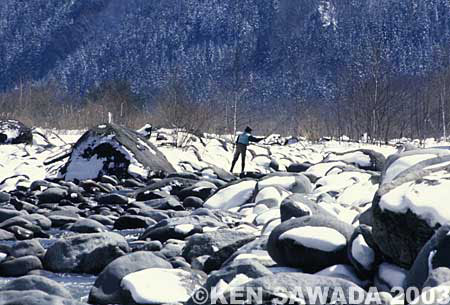
The water amount was only a tenth of high season. A little bit of water trickled between the wide banks downstream.
Long-Barbelled Giant Sedge
Another attractive point of the Takahara River was that it was rich in bait throughout the year. That was common with the Katsura River and the Oshino River although the scenery of those rivers including surroundings was completely different from the Takahara River. Rich bait enabled fish to grow big. Fish were much bigger than those in nearby rivers. In fact they were incredibly big for the river size.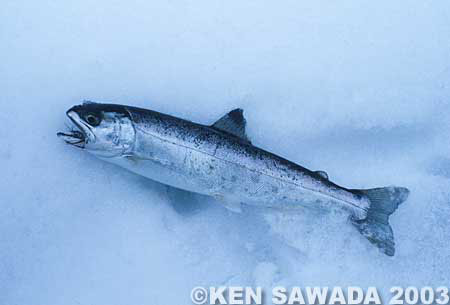
In the snow yamame trout which look like the smolt were caught.
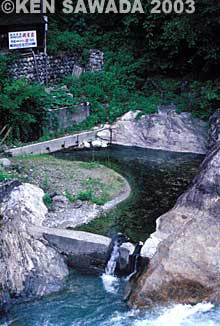
A large amount of hot spring welled up from the dry riverbed at upper reaches of Yarimi Bridge.
One of the bait that was indispensable and even exciting to both anglers and fish was sedge, to be precise, the biggest sedge called long-barbelled giant sedge. There are so many kinds of the aquatic insects so called sedge. Among them long-barbelled giant sedges live in rivers all over Japan. They are so nourishing that they make fish grow big.
When those long-barbelled giant sedges start emerging, fish become excited and attack them, neglecting any other food. In the peak of emerging season a large number of those sedges fly over the surface. It looks like a flurry of falling cherry blossoms in the wind. Then fish make rises excitedly, which causes anglers great excitement.
As those sedges tend to avoid bright sunshine, they emerge and fly exclusively in the evening and dawn. That means fish make evening rises and anglers are destined to be sleepless every night in emerging season.
There lived a lot of those sedges in the Takahara River. Evening rises reached the climax in the end of June. I first fished the Takahara River near Tochio in the end of June, 1982, the climax season (see Vol.17). In those days I enjoyed dry fly fishing until evening and later wet fly fishing for yamame trout that attacked the sedge. Actually, I caught nice ones.
I mean that the Takahara River brought me enormous enjoyment at the first fishing. If I had started fishing there in a different way, I would have had different images on the river.
Catching fish that attack sedge was the highest stage of wet fly fishing in the mountain stream. Anglers could enjoy the thrilling scenes which might never be seen at dry fly fishing.
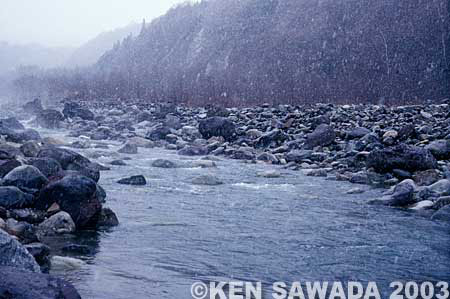
I left Imadakan for Karukaya. Fish were very active and responded to the fly even in the snow.
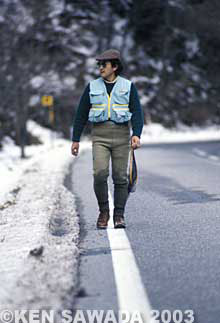
All the places except roads had been covered with snow until the middle of March.
Wild Canary and Orange Hawk were completed in the Takahara River. Both dry flies had power of fascinating very nervous fish which had always been attacked by many anglers. Several wet flies were born here and performed very well, too. The remarkable thing was that all the flies completed here never ended in local flies but turned into standard patterns available everywhere. Particularly, the wet flies always proved to be the first-class killer flies in the rivers where a large amount of sedge emerged, in other words, where big mountain-stream fish were staying.
In the Takahara River, fish often made rises on the surface due to rich aquatic insects. In addition to evening rise, yamame trout made rises here and there when small Olive hatched. In cold-water season that kind of rises usually happened at the warmest hours of the day. Fish responded very well to the dry fly. Then the Takahara River became famous for a lot of catch from spring. Fortunately or unfortunately, a good reputation made more anglers gather together year by year. Finally we had to stand side by side from upstream to downstream for a few days after the opening day.
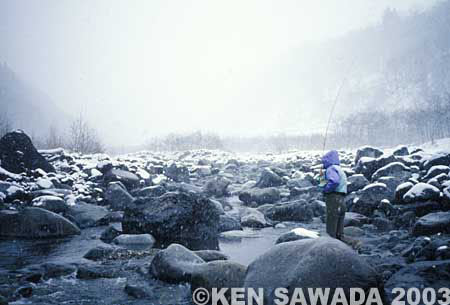
Near Shinzansoh just after the opening day of the Takahara River. Char attacked dry fly.
Before long anglers caught the most of yamame trout because the fish bit the fly so easily. A month later they became more cautious and nervous day by day. Then less and less anglers gathered. Finally I could enjoy aiming at big fish in less crowded river. I did not mind how difficult it was to catch them.
In those days yamame trout were filled up by stocking the river with yamame parr. Those of less than 10cm were released in the end of May every year. Then they grew up to be over 25cm in the warm water area on March 1st, the opening day of the next year and some of them more than 30cm in the end of April.
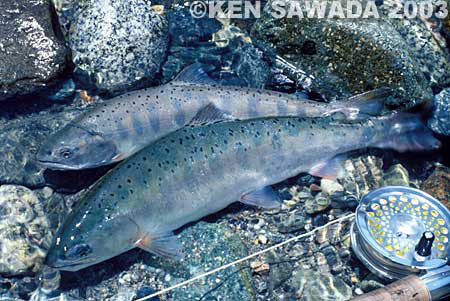
Yamame trout are the fattest in a year after snow melting season.
In short, early spring a lot of middle-sized yamame trout were caught in the crowded river. Then fish grew up rapidly and gave us a chance of catching big ones. Those big ones were quite rare although only a small number of anglers remained. In July there was a chance of catching trophy size ones but we had to fight a severe war of nerves with fish. That was the cycle of a fishing year of the Takahara River.
-- To be continued --
- NET SHOP INFORMATION
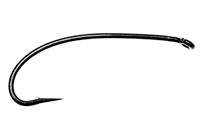
SL6 Black Spey Hooks
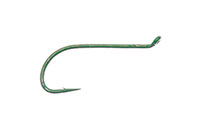
DU3 Limerick Spinner Hooks
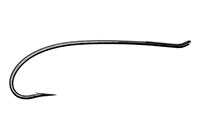
SL4 Single Bartleet Hooks
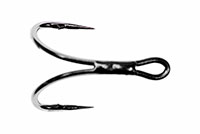
XD1 Tube Fly Double Hooks
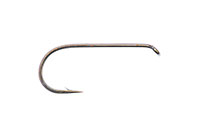
DD2 Flat Perfect Hooks
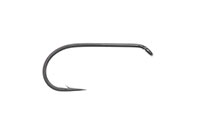
DD1 Black Terrestrial Hooks
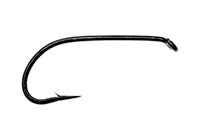
TD4 Old Limerick Wet Hooks
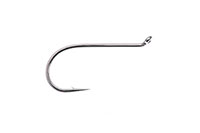
DU1 Silver May Hooks
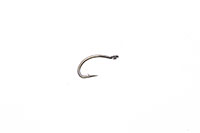
MU1 Flat Midge Hooks
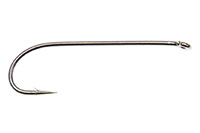
LD3 Long Limerick Hooks
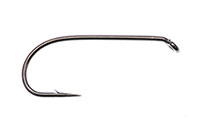
TD2 Summer Sproat Hooks
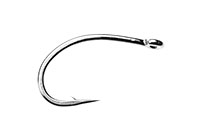
XS1 Tube Single Silver Hooks
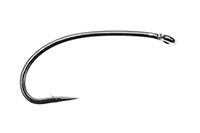
TD6 Siver Sedge Hooks

SL5 Black Spey Hooks

DU3 Limerick Spinner Hooks
- TROPHY CLUB
- FLY SHOW
- EXHIBITION
- MASTERS`
- FLY DRESSING CONTEST Archives
- TRAVELLER Archives
- TACKLE IMPRESSIONS Archives
- ANGLERS` PHOTO GALLERY Archives
- ----------------------------------------------
- トロフィークラブ
- フライショー
- エキシビション
- マスターズ
- フライドレッシング・コンテスト・アーカイヴ
- トラヴェラー・アーカイヴ
- タックル・インプレッション・アーカイヴ
- アングラーズ・フォトギャラリー・アーカイヴ
株式会社サワダ 185-0021 東京都国分寺市南町3-13-4
SAWADA'S INC. 3-13-4 Minamicho, Kokubunji, Tokyo 185-0021, Japan
写真・ドキュメントの無断転載を禁じます。
All the images and documents found on this site are owned by Ken Sawada and may not be used without permission.
But, link to this site is FREE.
Copyright © 2000 - 2025 SAWADA'S INC.. All rights reserved.
SAWADA'S INC. 3-13-4 Minamicho, Kokubunji, Tokyo 185-0021, Japan
写真・ドキュメントの無断転載を禁じます。
All the images and documents found on this site are owned by Ken Sawada and may not be used without permission.
But, link to this site is FREE.
Copyright © 2000 - 2025 SAWADA'S INC.. All rights reserved.
